Selling on Shopify and eBay doubles your audience, but it also doubles the chance of stock errors.
If your apps aren’t in sync, what looks available on one app may already be sold on the other. This could mean refund requests, negative reviews, and wasted time.
With Shopify eBay inventory synced, you can keep stock counts accurate in real time, no matter where the order comes from.
We’ll walk through how to set up Shopify eBay inventory sync, the common issues you might face, and the best apps to make the process seamless.
What Shopify eBay Inventory Sync Means
Shopify eBay inventory sync connects your product listings, stock levels, and orders across both platforms. When you add or update a product in Shopify, the changes, like price, quantity, or variations, automatically reflect on eBay.
Sell an item on eBay, and your Shopify stock adjusts instantly. The same happens in reverse, keeping both platforms accurate so you don’t oversell or display outdated inventory.
Even better, eBay orders flow directly into your Shopify dashboard, so you can manage fulfillment from one place without juggling multiple tabs or tools.
Here’s what all syncs across platforms
- Product listings: Titles, descriptions, images, SKUs, and pricing
- Inventory: Real-time stock updates between Shopify and eBay
- Orders: eBay sales appear in your Shopify dashboard
Goal is simple: Keep both platforms in sync without having to update each manually.
How to Set Up Shopify eBay Inventory Sync Quickly
Setting up Shopify eBay inventory sync requires a few key steps. Here’s how to do it right.
Step 1: Install an eBay connector app in Shopify
Go to your Shopify admin, click Apps, then Shopify App Store, and search for "eBay Sales Channel" or any approved eBay connector you prefer.
Click Add app and follow prompts to install it. Once installed, the app will appear in your Shopify dashboard under Sales Channels or Apps.
If you’re using the official eBay app, no sync-specific settings are needed at this stage. That comes later during account linking and product mapping.
For third-party apps, some might ask upfront about sync preferences.
Step 2: Connect your eBay seller account
After installing the connector app, open it from your Shopify dashboard. You’ll be prompted to sign in with your eBay seller credentials. Use the same eBay account where your listings will appear.
Some apps will ask you to select the eBay site/region (like eBay.com or eBay UK) and default currency and shipping settings.
Authorize the connection when eBay asks for permission to link with Shopify. This allows the app to access your listings, update inventory, and sync orders.
Step 3: Map products and match SKUs
Now it’s time to link your Shopify products to your eBay listings. If your products already exist on both platforms, use the Shopify SKU name to match them.
In the connector app, go to the Product Mapping or Listings section (label may vary by app). The app will scan your Shopify catalog and pull in your eBay listings.
You’ll usually see one of three options
- Auto-match by SKU: Ideal if SKUs are identical on both platforms
- Manual match: for products that need to be linked one by one
- Import Shopify products to eBay: for first-time eBay sellers
If the app has a toggle for “auto-link by SKU”, enable it only after confirming that your SKUs are clean and consistent. Otherwise, mismatches can trigger sync errors or duplicate listings.
Step 4: Enable inventory and order sync settings
Once products are mapped, go into the app’s Settings or Sync Preferences section. This is where you control how stock and orders update between Shopify and eBay.
Look for these key toggles
- Inventory sync: Turn this on so that when a product sells on one platform, the stock level updates on the other.
- Order sync: Enable this to pull eBay orders into your Shopify dashboard for fulfillment.
- Price sync (optional): Some apps let you keep pricing the same across both platforms or set eBay-specific rules. Only enable this if you want identical pricing.
Most connectors let you choose the sync direction (Shopify → eBay or two-way). If Shopify is your main catalog, set it as the source of truth to avoid conflicts.
Step 5: Test sync with a sample listing
Before syncing your entire catalog, run a quick test. Pick one product that’s already mapped and make a small change in Shopify, such as adjusting the stock quantity.
Check your eBay listing after a few minutes to confirm the update appears correctly. Then, do the reverse. Place a test order on eBay (or reduce stock manually) and see if the changes reflect in Shopify.
Best Settings for Shopify eBay Inventory Sync Without Overselling
Getting sync settings right is the key to avoiding stockouts, overselling, or customer cancellations.
Once your Shopify and eBay accounts are connected, review the following settings carefully.
1. Out-of-Stock option
Out-of-stock option on eBay controls what happens to a listing when the quantity reaches zero. If this is turned on, the listing remains active but hidden from buyers until stock is replenished.
If it is off, the listing ends completely, which means you’ll have to manually relist it once stock is available again.
For Shopify and eBay sync, it’s best to keep this setting on. This ensures that when inventory updates from Shopify show zero stock, the eBay listing pauses instead of disappearing.
It reduces risk of relisting errors and keeps the product’s sales history intact, which is important for search ranking on eBay.
2. Reserves
A reserve setting is when you intentionally hold back a small amount of stock from syncing to eBay. For example, if you have 20 units in Shopify, you can set the app to only show 18 on eBay, leaving 2 units as a buffer.
This setting is helpful when stock moves quickly across multiple channels. It prevents situations where Shopify and eBay both sell the last available units at the same time, leading to overselling and cancellations.
3. Sync frequency
Sync frequency controls how often inventory and order updates pass between Shopify and eBay. Some apps allow you to choose intervals, such as every 15 minutes, hourly, or daily.
The shorter the interval, the lower the chance of overselling, since stock updates reflect almost instantly after a sale.
For sellers with fast-moving items, the sync can be set to 15 minutes or less if available. Slower-moving catalogs can work fine with hourly updates. Daily sync is rarely suitable unless products are made-to-order.
4. SKU mapping
SKU mapping tells Shopify and eBay which listings belong together. The connector app relies on SKUs as the unique identifier, so mismatched or missing SKUs cause errors like duplicates or incorrect stock updates.
Enable “Auto-match by SKU” only if your SKUs are already consistent. If not, clean them up first. Each product should have a unique SKU, and variants should share a parent SKU with clear option values.
Accurate SKU mapping keeps updates tied to the right product, preventing overselling and sync failures.
5. Multi-location inventory
If you use multiple warehouses or fulfillment centers in Shopify, you’ll need to decide which locations feed inventory to eBay.
For accuracy, select the primary location that consistently fulfills eBay orders. If you enable all locations, make sure each is synced correctly, or you risk showing more stock than what is truly available for eBay buyers.
This setting ensures only the right stock pool is shared. Keeping it tied to one reliable fulfillment source usually works best.
6. Order import
Order import settings decide how eBay sales appear in Shopify. When enabled, every eBay order automatically creates a Shopify order with details like customer info, product SKUs, and shipping method. This keeps stock accurate because Shopify immediately reduces the available quantity.
Always keep this setting on. Without it, inventory may not update in time, creating risks. Check that imported orders also sync fulfillment status back to eBay so buyers see tracking updates.
7. Troubleshooting and error alerts
Most connector apps include a sync log or error alert option. This setting notifies you if a product fails to sync, an SKU doesn’t match, or stock updates are blocked.
Enable both email alerts and in-app notifications if available. Overselling often comes from unnoticed sync failures, so active monitoring ensures you catch problems quickly. Reviewing logs daily helps confirm everything is running smoothly.
Comparing Shopify eBay Inventory Sync Apps
Before diving into the details, here’s a quick side-by-side comparison of the most popular apps.
Top 5 Shopify eBay Inventory Sync Apps
The following five apps are some of the popular ones that can connect Shopify with eBay, each offering different features for sync speed, SKU mapping, multi-location support, and pricing.
1. Shopify Marketplace Connect

This is Shopify’s native integration for eBay, which means setup is simpler and support is direct. However, SKU mapping only works if SKUs match across both platforms, with no custom rules.
Shopify Marketplace Connect supports multi-location, but only one location can be selected as the sync source. Price rules are basic, with simple markup or currency conversion options. Overall, this option is best for sellers who want fast, stable sync without needing advanced customizations.
2. CedCommerce eBay Integration
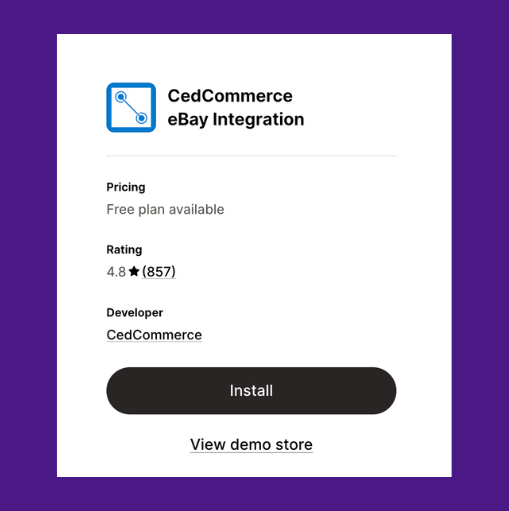
CedCommerce offers a detailed sync setup between Shopify and eBay. It supports near real-time updates depending on the plan.
You can bulk map or manually match SKUs, and choose which location supplies inventory.
Price rules are flexible, covering fixed, percentage-based, or promotional pricing. It is best for sellers who need tight control and advanced rule settings.
3. Sellbrite
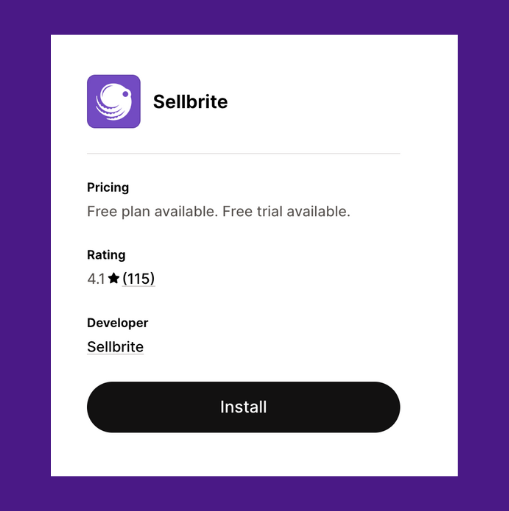
Next on the list is Sellbrite. Sellbrite runs inventory sync roughly every 15 minutes. It supports advanced SKU mapping, letting you manually correct mismatches or group SKUs. Multi-location inventory is also a strong point for this app, as you can combine or isolate stock by warehouse.
Price rules are flexible, with per-channel pricing, markup percentages, and min/max settings. Compared to Marketplace Connect, it gives more control but sacrifices some sync speed.
4. LitCommerce
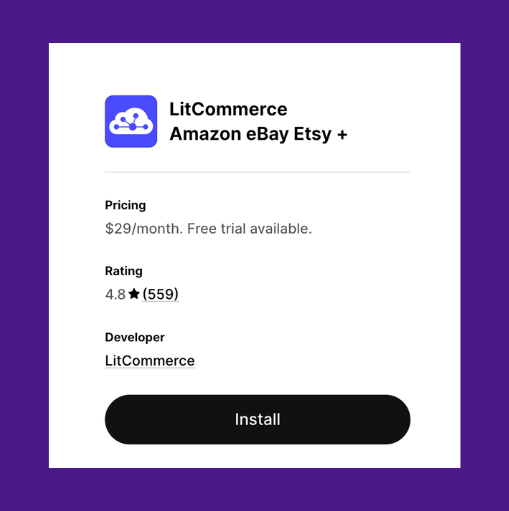
LitCommerce connects Shopify to multiple marketplaces, including eBay. It’s simpler to set up than others. Inventory and pricing sync happens every 15 minutes. You can map SKUs manually and choose which Shopify locations send stock to eBay.
Price rules allow rounding and percentage changes per channel. Overall, a good fit for sellers looking for control without heavy setup.
5. inkFrog
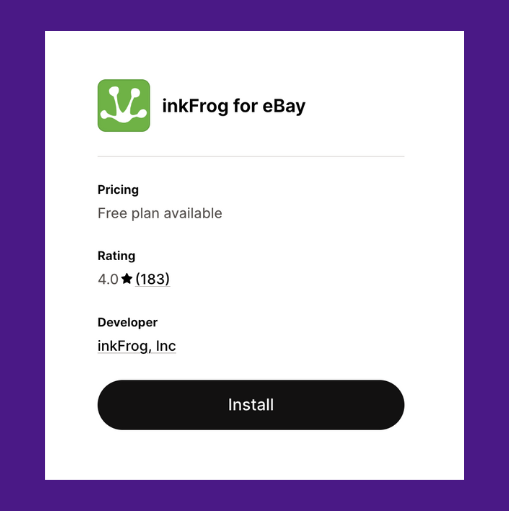
inkFrog focuses on eBay listing management with sync features built in. It updates inventory every 15 minutes.
The app focuses more on eBay listing control than deep multichannel inventory features. SKU mapping is available but limited. SKUs must match for syncing to work properly.
Multi-location handling is basic, usually working best with a single fulfillment source. Price rules exist but are simple, mostly fixed markups or currency changes. This is best for sellers who prioritize custom eBay templates over advanced sync features.
What to Do After Shopify eBay Inventory Sync
Once your Shopify eBay inventory sync is working, you’re not done. Syncing keeps stock levels accurate, but it doesn’t tell you how to divide stock between channels.
That’s where allocation comes in. Instead of showing all 100 units on both platforms, you decide how many to assign to Shopify vs eBay, to avoid overselling.
To decide those splits, you need smart forecasting. That tells you which channel will likely sell how much, so your allocation is data‑driven.
Enter Prediko, which is an AI‑powered inventory planning and management tool built for Shopify brands. It helps with
- AI demand forecasting (SKU and channel level): Prediko predicts future demand by factoring in seasonality, past sales, and growth trends for each product on every channel, so you know exactly how much stock to allocate and where.
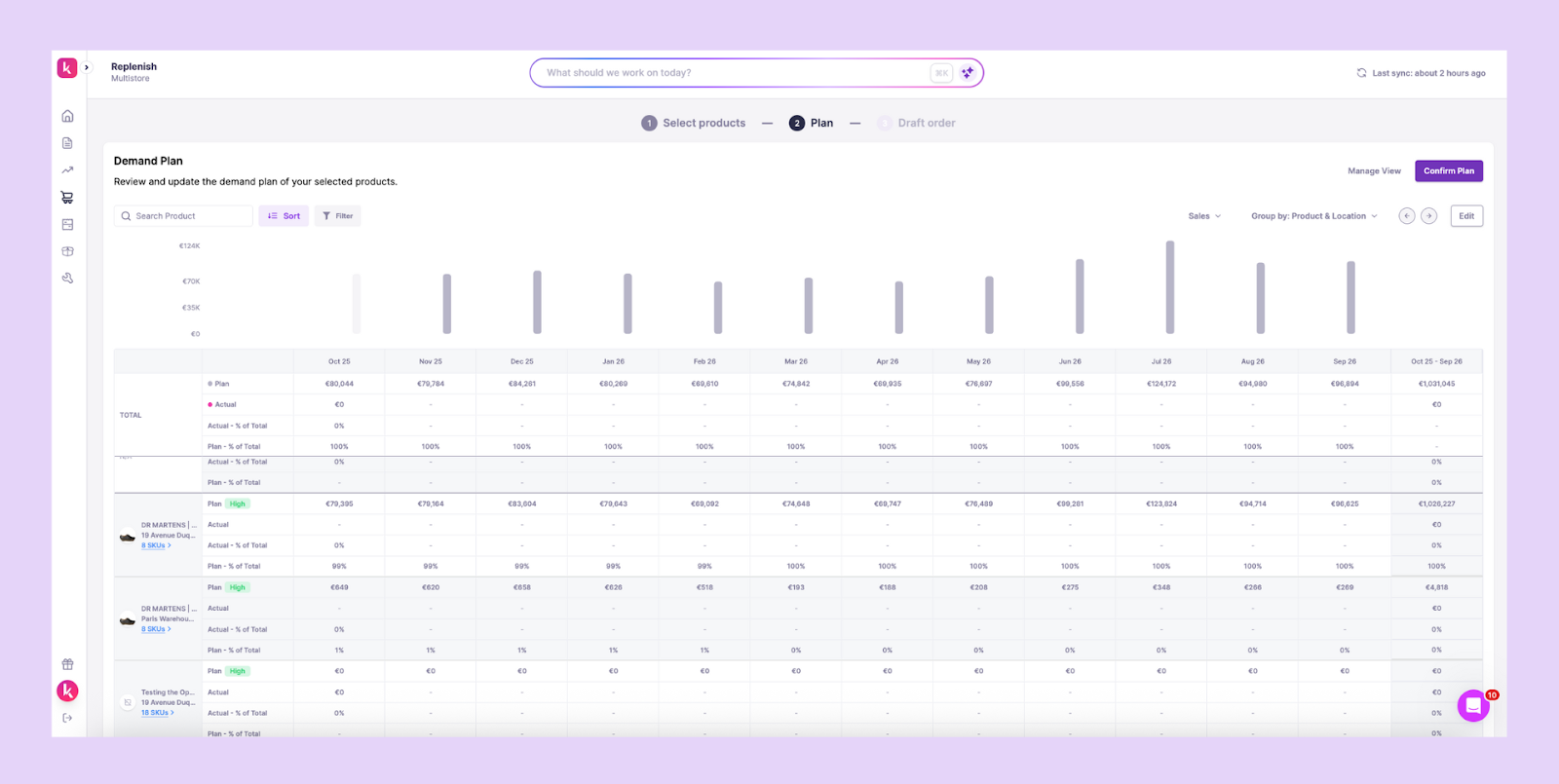
- Channel-specific purchase recommendations: If you don’t have enough inventory to meet projected demand across both channels, Prediko shares channel-specific purchase suggestions accounting for lead times so you don’t restock too late and miss eBay or Shopify orders.

- Raw materials management: For brands that manufacture in-house or rely on suppliers, Prediko connects finished goods demand with raw material needs.

- Analytics & reporting: Prediko consolidates sales and stock data across Shopify, eBay, and other connected platforms into one place. You can see which products are moving fastest, which are overstocked, and ABC analysis, all broken down by channel for deeper insight.
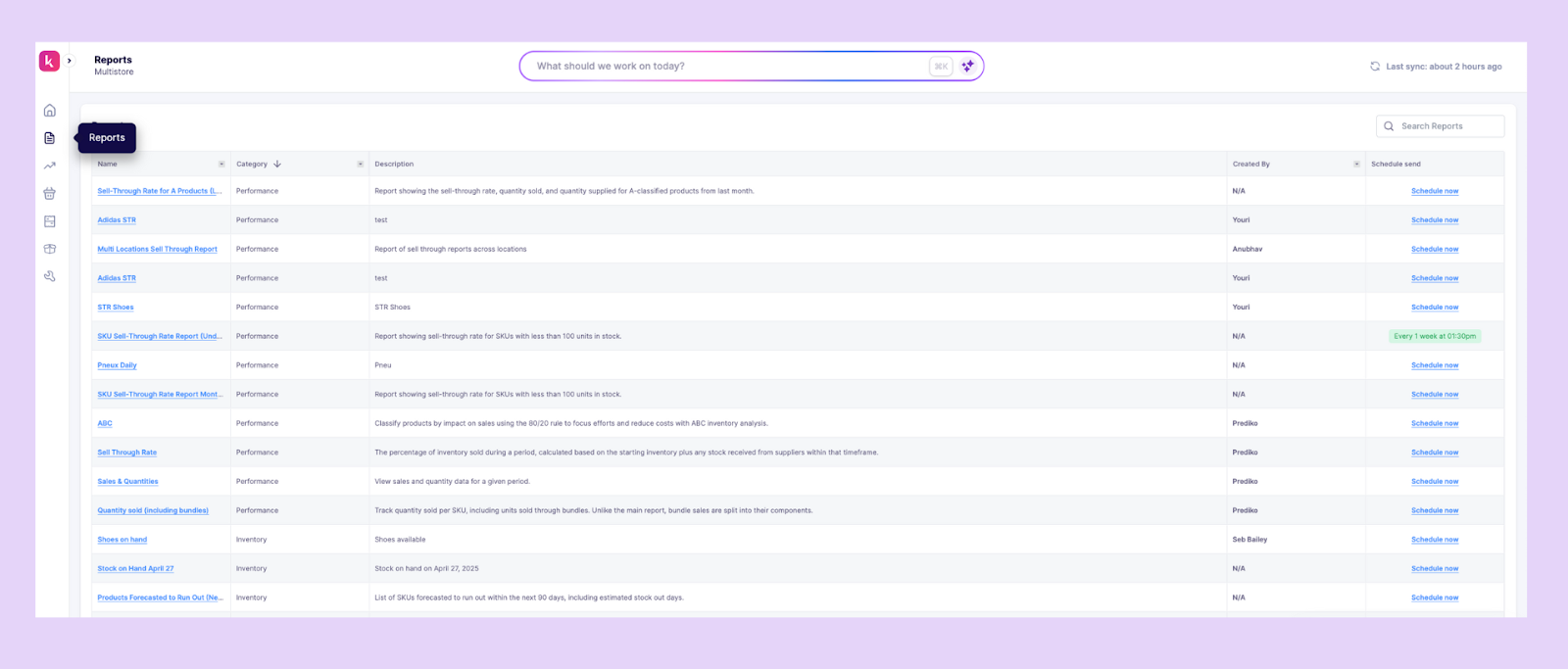
- Low-stock alerts (per channel): Prediko notifies you when stock is running low on each channel, whether it’s Shopify or eBay, so you can replenish before orders are lost.

So while sync handles communication between systems, Prediko handles decisions. It tells you how much stock to show on Shopify, how much on eBay, and when to replenish before you sell out.
That’s how you stay in control of inventory, not just synced, but smartly distributed.
Common Shopify eBay Inventory Sync Issues and Fixes
Even with your sync in place, issues can still crop up, leading to stock errors, missed orders, or overselling. Here are the most common problems and how to fix them.
1. Listings ending at 0
When inventory hits zero on eBay, some listings don’t reactivate even after restocking. This leads to lost visibility and missed sales. It happens when the eBay setting to keep out-of-stock items live is disabled.
Solution
Enable the out-of-stock option in your eBay settings. This keeps listings active at zero quantity, so they automatically relist when stock syncs from Shopify.
2. SKU mismatch blocks inventory updates
If SKUs in Shopify don’t exactly match what’s listed on eBay, the connector can’t sync inventory. This creates duplicate listings or leaves some products unsynced.
Solution
Clean up your product SKUs to ensure they’re identical across both platforms. Use your app’s manual SKU mapping feature if auto-match doesn’t work.
3. Wrong quantity shows on eBay
Your Shopify stock may be correct, but eBay shows higher or lower quantities. This often happens when sync pulls from the wrong location or uses total inventory across multiple warehouses.
Solution
Check your sync settings to select the right inventory location. Use an inventory management and allocation tool like Prediko to control how much stock gets exposed per channel.
4. Sync delays cause overselling
If your sync app only updates inventory on a schedule (e.g., every 15 minutes), back-to-back orders on Shopify and eBay can outpace the updates. This often causes overselling, especially with high-demand products.
Solution
Set your sync interval to the shortest option available in the app. Add a stock buffer or reserve to reduce the chance of both platforms selling the same units before the update happens.
Get Shopify and eBay Inventory Sync Smarter with Prediko
Once your channels are synced, inventory updates become automatic and easier. But overselling, misallocation, and stock delays don’t fix themselves. You need to know how much to sell, on which platform, and when to restock.
Prediko helps you do that. It forecasts demand by channel, automates purchase planning, and gives you the clarity to allocate smarter across both Shopify and eBay.
Start your 14-day free trial and see how Prediko helps handle the post-sync operations.
Frequently Asked Questions
1. Can Shopify sync with eBay?
Yes, Shopify can sync directly with eBay using apps like Shopify Marketplace Connect, Sellbrite, CedCommerce, LitCommerce, or inkFrog.
2. How much does Shopify charge for eBay integration?
The Shopify Marketplace Connect app is free to install for up to 50 orders/month. Some third-party apps charge monthly based on order volume or number of listings.
3. How to enable inventory sync on Shopify?
Install your preferred eBay connector app from the Shopify App Store. Link your eBay account, map your SKUs, and turn on inventory sync in the app settings.
Choose Shopify as the inventory source to ensure all stock updates reflect correctly on eBay.
4. How to transfer eBay listings to Shopify?
Use your sync app’s Import Listings feature. It pulls your active eBay listings into Shopify, including titles, images, SKUs, and prices. Make sure SKUs are clean so they don’t create duplicates or fail to link properly.
.svg)
.png)






